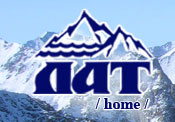| What
is orienteering?
Orienteering is the sport of navigation with map and compass.
Its official beginning dates back to a competition organized in
1897 in Norway by a sports club. The object is to run, walk, ski,
or mountain bike to a series of points shown on the map, choosing
routes–both on and off trail–that will help you find
all the points and get back to the finish in the shortest amount
of time. The points on the course are marked with flags and punches,
so you can prove you've been there. Each “control” marker
is located on a distinct feature, such as a stream junction or the
top of a knoll.
Orienteering is often called the “thinking sport” because
it involves map reading and decision-making in addition to a great
workout. Any kind of map may be used for orienteering (even a street
map), but the best ones are detailed five-color topographic maps
developed especially for the sport. These maps show boulders, cliffs,
ditches, and fences, in addition to elevation, vegetation, and trails.
Orienteering is that can be practiced by people of all ages and
physical conditions. The competitive athlete can experience the
exhilaration of running through the woods at top speed, while the
non-competitive orienteer can enjoy the forest at a more leisurely
pace. Most events provide courses for all levels–from beginner
to advanced–and the sport has been adapted for small children
and people in wheelchairs.
What is LAT’s role in orienteering?
One of LAT’s principal projects is organizing and participating
in orienteering competitions and training young orienteerists. We
conduct and participate in local and regional competitions, including
the yearly Buryatia Cup of Sports Orienteering and the “Race
of the Strongest” regional competition.
Many of our alum have gone on to win prestigious prizes in orienteering,
including at the Buryatia-wide, regional, and even national levels.
We believe that orienteering is an especially interesting and useful
sport in that it encourages both physical and mental development
as well as increasing an appreciation for nature.
|



